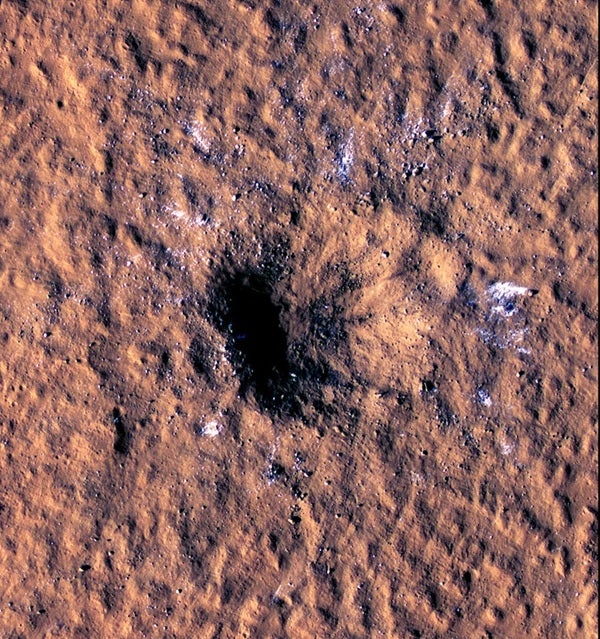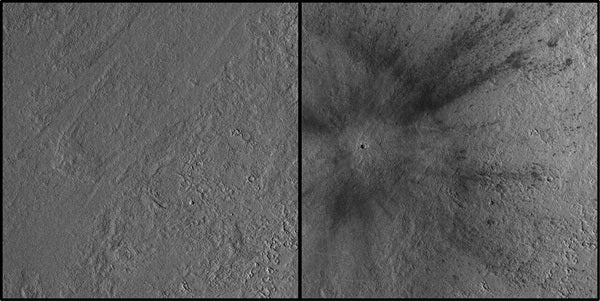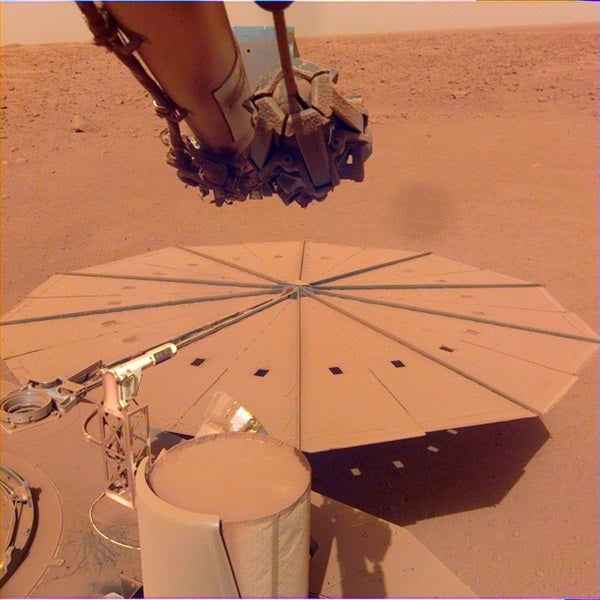On Christmas Eve 2021, NASA’s InSight Lander made Santa’s nice list and was gifted a magnitude 4 marsquake. It wasn’t until a few months later, on Feb. 11, however that scientists learned what had caused the ground to shake: an impact by one of the largest meteoroids NASA has ever seen strike Mars.
The resulting crater — some 492 feet (150 meters) across and 70 feet (21 meters) deep — was spotted by NASA’s Mars Reconnaissance Orbiter (MRO). It is believed to be one of the largest craters scientists have ever witnessed forming in the solar system.
Thanks to the MRO images, researchers learned InSight’s rumbling present was topped with an icy bow, as the impactor had ejected boulder-sized chunks of ice. This ice is closer to the equator than any other surface ice yet found on Mars — a crucial discovery that will help inform NASA’s future plans to send crewed missions to the Red Planet.
“It’s unprecedented to find a fresh impact of this size,” said Ingrid Daubar of Brown University, who leads InSight’s Impact Science Working Group, in a NASA press release. “It’s an exciting moment in geologic history, and we got to witness it.”
Details about the impact are presented in two papers published Oct. 27 in Science.
Watch your head
The impacting meteoroid is expected to have been some 16 to 39 feet (5 to 12 m) across. Earth sees similarly sized asteroids target our planet about once per year, but normally they burn up in our thick atmosphere. However, with an atmosphere just 1 percent as dense as Earth’s, Mars isn’t so lucky.
“The image of the impact was unlike any I had seen before, with the massive crater, the exposed ice, and the dramatic blast zone preserved in the martian dust,” said Liliya Posiolova, who leads the Orbital Science and Operations Group at Malin Space Science Systems, which operates two of MROs cameras. “I couldn’t help but imagine what it must have been like to witness the impact, the atmospheric blast, and debris ejected miles downrange.”
The ejecta was blasted as far as 23 miles (37 kilometers) away. And while a magnitude 4 earthquake doesn’t rank very high on Earth, it’s one of the strongest yet detected on Mars, as well as the first to exhibit surface waves. These waves ripple across the top of a planet’s crust. So, if someone had been standing on the surface of the Red Planet, they would have felt the ground shake.
Ice ice baby
NASA hopes to add Mars to the list of worlds that humans have explored in person, but doing so will require meticulous planning. A vital resource to consider? Accessible ice. Astronauts would be able to use it for a variety of needs, such as drinking water, agriculture, and even rocket propellant.
Another hurdle to consider: Warmth. Like Earth, Mars’ equator is its warmest region, thus NASA might want to keep astronauts as close to this location as possible.
So — because the surface ice uncovered by this meteorite is the closest to the martian equator yet found, at 35°N — the discovery marks good news for future crewed missions to Mars.
“This was a big surprise because this is the closest to the equator that we’ve seen ice exposed in an impact,” said Daubar in the press conference announcing the discovery. “It wasn’t totally out of range of what might be expected, but it was still very surprising.”
As for how the researchers know the ice came from Mars and not the impactor, the answer is simple: “An impact of this size would actually destroy the meteoroid,” explained Daubar. Additionally, the spray of debris indicates that the ice is not from the impacting body, but rather excavated from Mars itself.
Final goodbye?
The InSight lander has been recording seismic activity on Mars since touching down in 2018. But earlier this year, NASA announced that dust accumulation was significantly depleting its batteries. And a month ago, a large dust storm left the team on the edge of their seat, wondering if it would spell doom for the intrepid lander.
“Fortunately, that dust storm did not move over InSight itself,” said Bruce Banerdt, InSight principal investigator of NASA’s Jet Propulsion Laboratory, in the press conference. “Unfortunately, since this is such a large dust storm, it’s actually put a lot of dust up into the atmosphere.” This has significantly cut down the amount of Sun reaching the lander’s solar panels.
Currently, the team estimates that the InSight lander might have only 4 to 8 weeks left.
“I know it’s going to be hard for the team and all of us to say goodbye” said Lori Glaze, director of NASA’s Planetary Science Division. “But what an awesome capstone science result to end on. I mean literally going out with a bang!”












